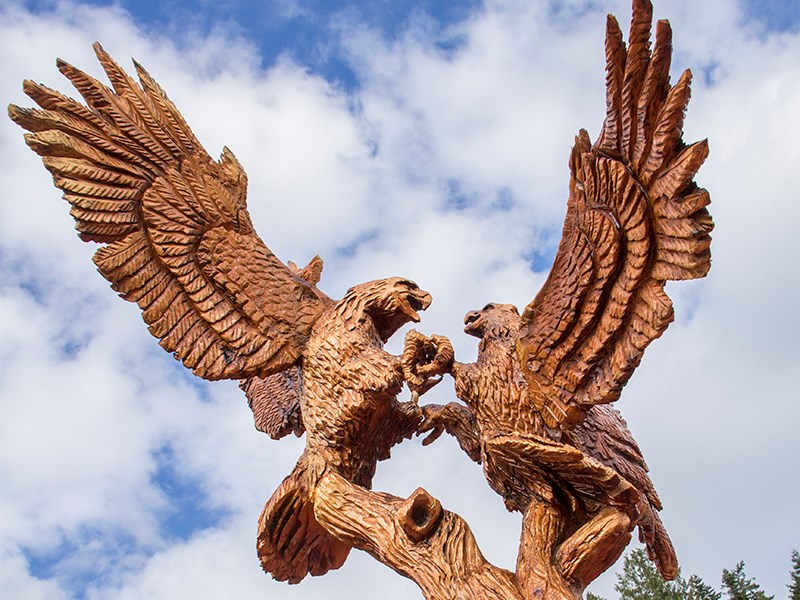There is not enough outdoor public art in Powell River, according to the local arts community. What public art there is can sometimes be difficult to find, often hidden from view or unnoticed by passersby.
The Powell River arts community wants to bring public art out of the shadows and into the light, but just as art is subjective, so too are the opinions around public art, even the very issue of needing it or not.
“We don't even have a collective awareness that we're lacking public art,” said Ann Nelson, ambassador for Powell River Council for Arts and Culture, a non-profit society she helped form in 2006 that administers arts, culture and heritage funding for City of Powell River.
The arts council recently began work on a new public arts centre funded by a Powell River Community Forest grant of up to $150,000 after city council approved a lease for a location above the new Powell River Public Library.
The arts council is still in the process of developing programs and exhibits, but public art has definitely entered the discussion, according to council president Nina Mussellam.
“Public art has been talked about,” confirmed city councillor CaroleAnn Leishman, who holds the arts, culture and heritage portfolio with the city and is an ex-officio member of the arts council. “We have talked about doing a public art program, possibly a mural festival because we do have some historic murals that were done years ago. Maybe we want to expand on that.”
Murals are popular and a relatively inexpensive public art form, requiring only paint, a white wall and an idea.
The murals along Marine Avenue, which run the gamut from illustrating archival photos from Powell River’s history to contemporary street pieces done by such graffiti artists as Stefan Fogarty (also known as Catnip).
Commissioned under a city partnership, Colin MacRae’s functional metal sculptures that are both art and bike racks have drawn praise. There are also benches, banners, gateways and signs.
Another inexpensive way to bring art into the street, something done in other coastal communities, is decorating BC Hydro and Telus electrical boxes, according to Nelson.
Public art installations can be expensive, but Leishman said ways can be found to incorporate art into the community at lower costs.
“We're not talking about tens of thousands of dollars for a bronze statue that's going to be erected in the town square,” she said. “That would be a different conversation.”
Beyond the arts council, artists and gallery patrons, most residents don’t appear to notice that there isn’t much art out and about Powell River.
“A very small demographic feels we're lacking it at this point,” said Leishman.
The larger population that doesn’t see the for need public art point to what surrounds us, according to award-winning Powell River metal sculptor Heather Wall. Her work is installed in South Dakota, Minnesota, Wisconsin and cities in BC, but not here.
“We've got all of this stuff behind us that is pretty awesome, and the stuff in front of us; all of that ocean," said Wall. "But the actual city of Powell River has nothing that's iconic or grand or brings our community together.”
One of the the first contemporary public art sculptures to appear in Powell River gives some insight into the general ambivalence toward public art. It is a sculpture that was tucked away because it got in the way on the concourse of the Powell River Recreation Complex, according to Nelson.
The current public art collection around town is highlighted by first nation totem poles. Some of the strongest representations of those are at Tla’amin Nation government house and Brooks Secondary School, where a welcome figure was recently installed.
Since arriving in Powell River in 2011, Wall said aboriginal art is the dominant theme that she has seen.
“I think that's great," she said, "but there's no other public space artwork. There’s no sculptures for the sake of sculpting, like a fine art piece.”
Recently, within the last two years, the city has started to take notice of another art form.
“Look at the logger sports carvings,” said Mussellam. “Look at those lovely sculptures we're getting in the city.”
Due to the return of the popular event, Powell River has an inventory of chainsaw carvings that is multiplying.
There have been 22 carvings created from the past two logger sports events, 10 from 2016 and 12 from this year.
“The city gives $6,500 to sponsor the carving event at Powell River Logger Sports,” said Leishman. “In exchange for that sponsorship, we get first pick of the three carvings that we would like to obtain as public art for the community.”
The city currently has six large wooden animals through its logger sports sponsorship.
“If the logger sports carving competition continues on for a number of more years we could theoretically be inundated with carvings,” said Leishman. “Where do we put them? We don’t want to tuck them away in a corner.”
Among its many benefits, public art builds a sense of community, diversity, civic identity and culture. It can also transform wasted space.
“The minute that you put in something that will generate a conversation, then that city space becomes alive again,” said Wall. “It becomes a go-to place.”



